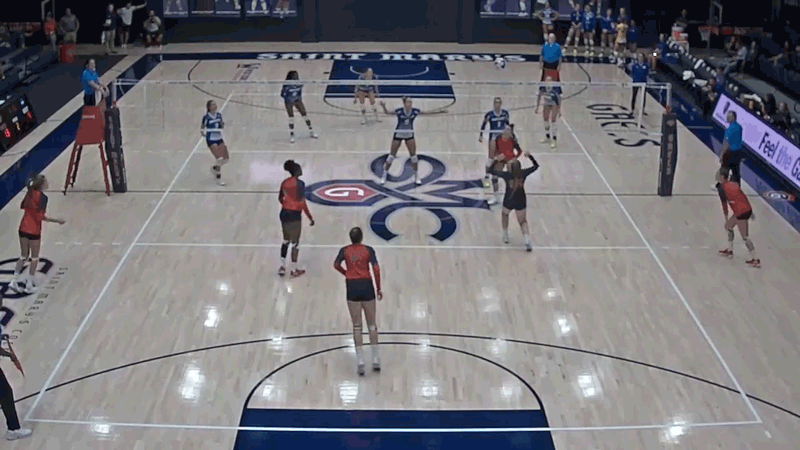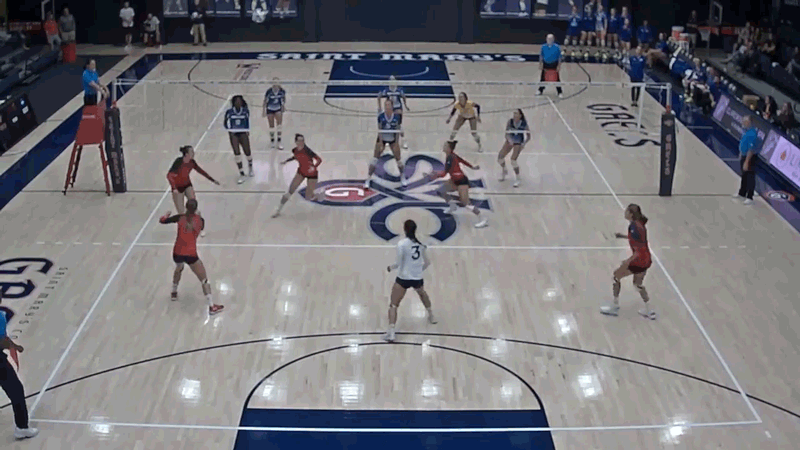Witten by Rob Browning, Head Volleyball Coach, Saint Mary’s College
I started coaching as a men’s volleyball coach. I rarely saw setters attempt to score a “set-over” kill, so when I became the head women’s volleyball coach at Saint Mary’s, I was not a fan of set-over attempts.
Along came Missy White, one of the best setters Saint Mary’s has ever had and the best at the set-over that I have ever seen. She could execute it flawlessly and her success rate was phenomenal. She was so good that other coaches would ask me how to teach it. I had to admit that I didn’t teach her a thing about it, she knew how to do it and did it on her own.
But I was now a big fan of the set-over.
The premise of the set-over is that a setter can sneak in a kill on a ball that is disguised as a set. It is commonly used when the setter is back-row, but a front-row setter, who is not close enough to the net to throw down a one-handed dump, can also do it.
Here are a few examples of perfectly executed set-overs:


KEYS
The keys to an effective set-over are:
- Disguise it as a set as much as possible.
- Get the ball to the floor as quickly as possible.
The fastest way to get the ball to the floor is to shoot it fast and low over the net. The ball has to get past the blocker first, so it has to be fast, and it has to beat the back-row’s reaction time so it should cross the net no higher than one foot above the tape–preferably just a couple of inches above the tape. Executed properly, the ball should land just behind the 10-foot line in the center of the court.
Our setters set over with a foot on the ground because that’s how they usually set. Smaller setters can probably get away with a jump set-over while back row because the ball still wouldn’t be above the top of the net.
TECHNIQUE
The important aspects of the technique are:
- Body posture should be the same as it would be on a typical set.
- Hands go from typical ball-shaped overhead, to shooting sideways to the target.
EXECUTION
The important aspects of execution are:
- Ball shoots fast and low over the net.
- By shooting it fast and low, it will usually land just past the 10′ line, right in the middle. This target is best regardless of where the setter is setting from because it is typically farthest from any defender. Also, set-overs can successfully land inside the 10′ line, depending on the origin of the attack.
- Timing is random and unexpected. The set-over can be successfully executed from anywhere inside the 10′ line and within 5′ of either sideline, although it becomes more difficult the closer the setter is to zone 4. It can be executed effectively in a first-ball-sideout situation or in transition.
GUIDELINES
The same general guidelines that apply to a setter dump apply to the set-over:
- Success rate should be high–at least as high as your best attackers’ hitting efficiency.
- Frequency relates directly to success rate. The more your setter attacks, the more the defense will be prepared to stop it.
- Frequency should not be so high that it disrupts the flow of your offense or your hitters’ rhythm. (One could argue that as long as your setter can successfully attack at a higher efficiency than your best hitters, the more the better. But #2 above will inevitably come into effect.)
If you don’t like the set-over, part of that is probably because you hate when other teams do it—because it works. As my assistant says, “if the other team hates something we do, then let’s do it more.” They will make defensive adjustments to make sure it doesn’t happen, which will open up other offensive opportunities
